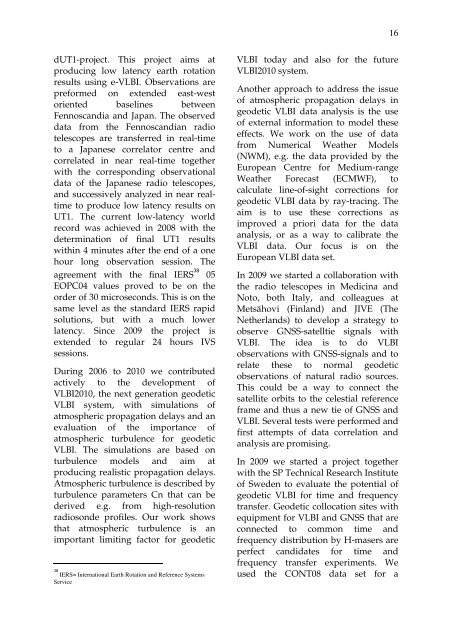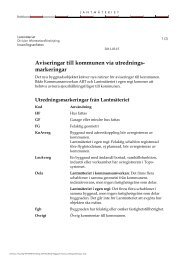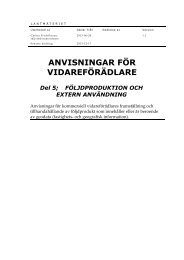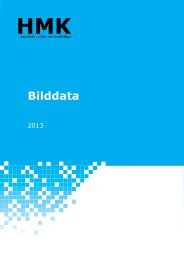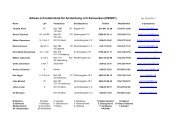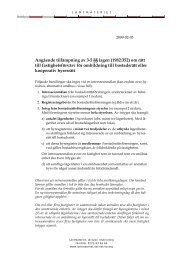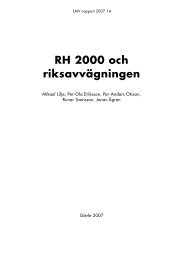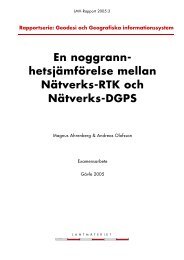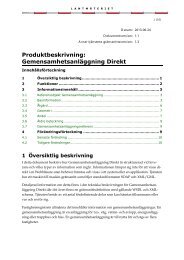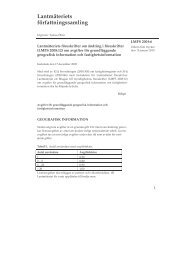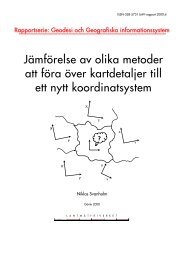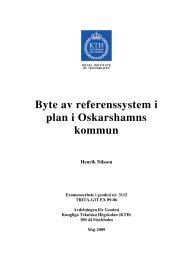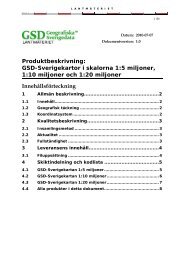National Report of Sweden to the NKG General ... - Lantmäteriet
National Report of Sweden to the NKG General ... - Lantmäteriet
National Report of Sweden to the NKG General ... - Lantmäteriet
Create successful ePaper yourself
Turn your PDF publications into a flip-book with our unique Google optimized e-Paper software.
16dUT1-project. This project aims atproducing low latency earth rotationresults using e-VLBI. Observations arepreformed on extended east-wes<strong>to</strong>riented baselines betweenFennoscandia and Japan. The observeddata from <strong>the</strong> Fennoscandian radiotelescopes are transferred in real-time<strong>to</strong> a Japanese correla<strong>to</strong>r centre andcorrelated in near real-time <strong>to</strong>ge<strong>the</strong>rwith <strong>the</strong> corresponding observationaldata <strong>of</strong> <strong>the</strong> Japanese radio telescopes,and successively analyzed in near realtime<strong>to</strong> produce low latency results onUT1. The current low-latency worldrecord was achieved in 2008 with <strong>the</strong>determination <strong>of</strong> final UT1 resultswithin 4 minutes after <strong>the</strong> end <strong>of</strong> a onehour long observation session. Theagreement with <strong>the</strong> final IERS 38 05EOPC04 values proved <strong>to</strong> be on <strong>the</strong>order <strong>of</strong> 30 microseconds. This is on <strong>the</strong>same level as <strong>the</strong> standard IERS rapidsolutions, but with a much lowerlatency. Since 2009 <strong>the</strong> project isextended <strong>to</strong> regular 24 hours IVSsessions.During 2006 <strong>to</strong> 2010 we contributedactively <strong>to</strong> <strong>the</strong> development <strong>of</strong>VLBI2010, <strong>the</strong> next generation geodeticVLBI system, with simulations <strong>of</strong>atmospheric propagation delays and anevaluation <strong>of</strong> <strong>the</strong> importance <strong>of</strong>atmospheric turbulence for geodeticVLBI. The simulations are based onturbulence models and aim atproducing realistic propagation delays.Atmospheric turbulence is described byturbulence parameters Cn that can bederived e.g. from high-resolutionradiosonde pr<strong>of</strong>iles. Our work showsthat atmospheric turbulence is animportant limiting fac<strong>to</strong>r for geodetic38IERS= International Earth Rotation and Reference SystemsServiceVLBI <strong>to</strong>day and also for <strong>the</strong> futureVLBI2010 system.Ano<strong>the</strong>r approach <strong>to</strong> address <strong>the</strong> issue<strong>of</strong> atmospheric propagation delays ingeodetic VLBI data analysis is <strong>the</strong> use<strong>of</strong> external information <strong>to</strong> model <strong>the</strong>seeffects. We work on <strong>the</strong> use <strong>of</strong> datafrom Numerical Wea<strong>the</strong>r Models(NWM), e.g. <strong>the</strong> data provided by <strong>the</strong>European Centre for Medium-rangeWea<strong>the</strong>r Forecast (ECMWF), <strong>to</strong>calculate line-<strong>of</strong>-sight corrections forgeodetic VLBI data by ray-tracing. Theaim is <strong>to</strong> use <strong>the</strong>se corrections asimproved a priori data for <strong>the</strong> dataanalysis, or as a way <strong>to</strong> calibrate <strong>the</strong>VLBI data. Our focus is on <strong>the</strong>European VLBI data set.In 2009 we started a collaboration with<strong>the</strong> radio telescopes in Medicina andNo<strong>to</strong>, both Italy, and colleagues atMetsähovi (Finland) and JIVE (TheNe<strong>the</strong>rlands) <strong>to</strong> develop a strategy <strong>to</strong>observe GNSS-satelltie signals withVLBI. The idea is <strong>to</strong> do VLBIobservations with GNSS-signals and <strong>to</strong>relate <strong>the</strong>se <strong>to</strong> normal geodeticobservations <strong>of</strong> natural radio sources.This could be a way <strong>to</strong> connect <strong>the</strong>satellite orbits <strong>to</strong> <strong>the</strong> celestial referenceframe and thus a new tie <strong>of</strong> GNSS andVLBI. Several tests were performed andfirst attempts <strong>of</strong> data correlation andanalysis are promising.In 2009 we started a project <strong>to</strong>ge<strong>the</strong>rwith <strong>the</strong> SP Technical Research Institute<strong>of</strong> <strong>Sweden</strong> <strong>to</strong> evaluate <strong>the</strong> potential <strong>of</strong>geodetic VLBI for time and frequencytransfer. Geodetic collocation sites wi<strong>the</strong>quipment for VLBI and GNSS that areconnected <strong>to</strong> common time andfrequency distribution by H-masers areperfect candidates for time andfrequency transfer experiments. Weused <strong>the</strong> CONT08 data set for a


